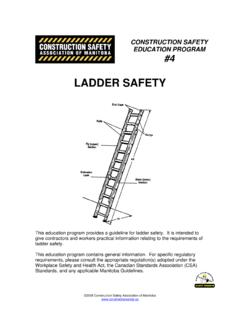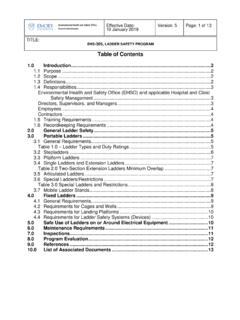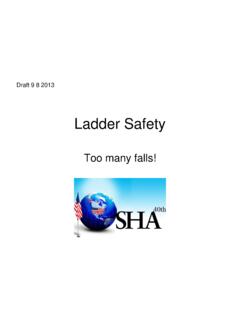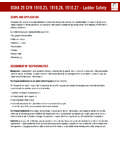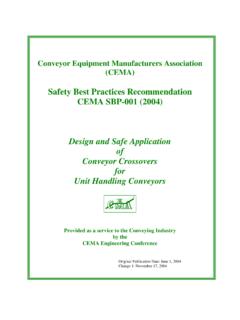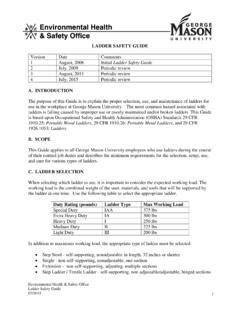Transcription of 227 Step Ladder Safety - KDC Construction
1 Tailgate/Toolbox Safety TrainingSafety Services Company- Safety Meeting Division, PO Box 6408 Yuma, AZ 85366-6408 Toll Free (866) 204-4786 227 Safety Services Company Company Name: _____ Job Site Location: _____ Date: _____ Start Time: _____ Finish Time: _____ Foreman/Supervisor: _____ Topic 227: step Ladder Safety Introduction: OSHA defines a step Ladder as a self-supporting portable Ladder , non-adjustable in length that has flat steps and a hinged back. Length is measured along the front edge of a side rail. Standard step -ladders should be used only on surfaces that offer firm, level footing such as floors, platforms, and slabs. step -ladders are available in metal, wood, or reinforced fiberglass versions, and are intended to support only one worker at a time. Remember not to stand on, or work from, the top step . The ladders must have a metal spreader or locking arms and they can not be longer than 20 feet, measured along the front edge of the side rails.
2 step -ladders are easier and safer to use when you match them with the appropriate task. Still, most portable- Ladder accidents happen when workers do one or more of the following: fail to inspect ladders regularly, place ladders inappropriately, or ignore safe practices when climbing or descending. When using a step - Ladder , always observe these Ladder Safety guidelines: Select the appropriate Ladder for your task or job and place the Ladder close to the work you are doing. Inspect the Ladder before you use it. Make sure it is in sound condition clean and undamaged. Protect an occupied Ladder if it could be struck by vehicles or pedestrians. Never place a Ladder in front of an unlocked, unguarded door. Do not set a Ladder up on boxes, tables, trucks, or other moveable objects. Keep the area around the top and bottom of a Ladder free of debris. Avoid carrying awkward loads when ascending or descending a Ladder or placing tools or materials on a Ladder if they could fall off.
3 Raise and lower heavy, awkward loads with a hand line or hoist. Attach light , compact tools or materials to the Ladder or to yourself. Never climb ladders when your hands or shoes are slippery. When ascending or descending ladders, always observe the 3 point climbing rule: Keep two hands and one foot or one hand and two feet on the Ladder at all times. Never use a metal Ladder with conductive side rails near exposed, energized equipment. Such ladders must be permanently, legibly marked with the words: WARNING Do Not Use Around Energized Electrical Equipment. Make sure only one person stands on, or works from, a standard Ladder . (Use a second Ladder if two or more people are doing the same task.) Immediately inspect any Ladder that has collapsed, tipped over, or been exposed to oil or grease.
4 Clean and repair the Ladder if necessary. Remove defective ladders from service. Tag or mark defective ladders with the words: Dangerous, Do Not Use. Keep the load on the Ladder (including yourself) below its maximum load capacity. Do not paint ladders because paint conceals defects. Use transparent preservatives instead. Never use ladders with broken, patched, oily, or cracked rails, rungs, or steps. Exercise caution while on a Ladder ; do not reach out over the side rails, lean, or turn excessively on a Ladder . Avoid using a self-supporting Ladder without first opening it up and securing the metal spreader or locking device. When carrying a Ladder , keep the front end elevated, especially around blind corners, in aisles, and through doorways. Ladder training Employers have a responsibility to ensure that their employees understand how to inspect and use ladders correctly.
5 A training program must be provided which enables each employee who uses a Ladder to recognize and minimize Ladder hazards. When applicable, a competent person must train each employee in the following areas: The nature of fall hazards in the work area How to correctly use, place, handle, and maintain ladders The maximum load-carrying capacities of ladders used OSHA requirements for the types of ladders that will be used Conclusion: Begin your work with a Ladder that will not let you down. Neglected ladders quickly become unsafe ladders. step bolts slacken, step sockets and other joints work loose, hole sizes increase eventually the Ladder becomes twisted and unstable. Maintenance includes regular inspection of the Ladder , repairing damage, and tightening step bolts and other fastenings. Periodic maintenance extends a Ladder s life and saves replacement costs.
6 Work Site Review Work-Site Hazards and Safety Suggestions: _____ _____ Personnel Safety Violations: _____ Material Safety Data Sheets Reviewed: _____ (Name of Chemical) Employee Signatures: (My signature attests and verifies my understanding of and agreement to comply with, all company Safety policies and regulations, and that I have not suffered, experienced, or sustained any recent job-related injury or illness.) _____ _____ _____ _____ _____ _____ _____ _____ _____ _____ _____ _____ _____ _____ _____ _____ _____ _____ _____ _____ _____ Foreman/Supervisor s Signature: _____ These guidelines do not supercede local, state, or federal regulations and must not be construed as a substitute for, or legal interpretation of, any OSHA regulations.




